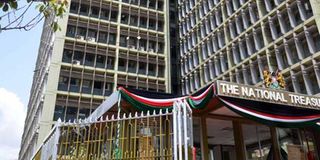Lack of sagacity in borrowing is burying Kenya in deep debt hole

The National Treasury. A feisty war of words is on concerning the government’s and country’s ballooning debt and the Treasury is at pains to argue that both are under control. FILE PHOTO | NATION MEDIA GROUP
What you need to know:
At the personal level, people often borrow when they do not have enough current income to pay all their expenses.
Expenditure has fast outstripped income, leaving them increasingly strapped for cash in the second half of the fiscal year.
Getting government-related bills paid in April, May and June is often an uphill task.
A feisty war of words is on concerning the government’s and country’s ballooning debt.
The National Treasury is at pains to argue that both are under control.
Deputy President William Ruto has also chipped into the debate, saying that “we are borrowing with discipline” and “we are a responsible and prudent working administration”.
But the International Monetary Fund and several other entities have called for restraint.
Indeed, there is growing consensus that our government and international debt has grown too big and too fast and must be contained. On top of that is the quality or value of the projects borrowed for.
PERSONAL EXPENSES
At the personal level, people often borrow when they do not have enough current income to pay all their expenses, in order to make up the difference.
Another reason is when the monthly salary or wage cycle means the cash flow gets tight in the run up to the next payment and one borrows to tide one over to the month-end.
The third is when one embarks on a project that requires large amounts upfront. One borrows a lump sum and repays it over an agreed period.
As our indebtedness grows, our overall ability to pay our way or remain in credit on a day-to-day basis is reduced.
We have several options which we often use concurrently. We can delay paying some bills, cut back on our expenses or borrow to pay the most pressing bills. At worst, we can borrow more to pay the interest on borrowed money or when the loan has matured.
DILEMMAS
Over the years, our governments have got themselves into similar — some would say, much greater — dilemmas.
Expenditure has fast outstripped income, leaving them increasingly strapped for cash in the second half of the fiscal year.
Getting government-related bills paid in April, May and June is often an uphill task.
The government then delays paying bills and cuts back on expenditure. The danger with the latter is that it is easier to cut back on development projects and plans than day-to-day operations and maintenance, such as wages.
A project to improve a medical centre will get slashed but its employees’ wages will continue.
The government has a double-edged problem: Income from taxes and other revenues is not enough for its day-to-day running.
The tax revenues in the first seven months of this 2017/2018 financial year were insufficient to pay for the recurrent expenditure obligations of Sh766 billion for the period.
In short, it has to borrow to make up payment shortfalls in day-to-day operations. It is running to stand still from day one.
Despite concerted efforts to strengthen the revenue base, the shortfalls continue.
On top of that is the current and past governments’ borrowing splurge to fund projects. The IMF is particularly concerned how the government has clocked up debt with comparative speed and ease in the past decade.
DEBT REPAYMENT
The symbiotic twin to the accumulating that debt is increasing debt repayments that obviously eat into what one can spend on day-to-day running costs, let alone new projects.
If the debt that has been accumulated had been for value-for-money, solid projects, then the government would at least be able to hold its head high.
But if one breaks down some of the projects and measure them against the yardstick of value, they come out poorly.
The SGR comes to mind. We have borrowed heavily to build an expensive railway whose passenger fares struggle to pay its running costs even though it is fully booked. Worse, it is failing to attract much commercial freight and Kenya Railways has resorted to arm-twisting people to send cargo on it.
To add insult to injury, the government now wants to electrify the line and is already working on the next stage.
We are pouring billions of shillings into a project that eats money like nobody’s business and will struggle to pay its way for years, that the taxpayer will have to subsidise for the foreseeable future and our children will be paying for in years to come.
Mr Shaw is an economic and public policy analyst. [email protected].





